Memory
RUSSIAN AMBASSADOR ALEXANDER KONUZIN EXCLUSIVELY FOR ”NATIONAL REVIEW” ABOUT THE MAGNIFICENT HERITAGE OF RUSSIAN ARCHITECTS IN BELGRADE
Our Duty Is To Remember
They were the flower of Russian national elite and then suddenly lost everything. Thousands of them came to Serbia, which they found as a new motherland, paying it back in the same way. In twenty years (1921-1941) they designed and built several thousands of objects here, among them more than two thousand in Belgrade. Government buildings, the royal palace, churches, palaces, villas, even cemeteries. They built themselves and their talent into the recognition of Serbian cities, leaving us discrete clues about their origin, before fate moved them further, towards new shores
By: Alexander Vasilevich Konuzin
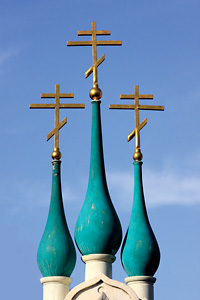 Due to the nature of my business, I had the opportunity to travel throughout the world. I visited dozens of capitals for business trips, multilateral meetings, assemblies of international organizations, bilateral consultations, etc. Each time, whenever circumstances allowed, I tried to go out into the city, to see the life in the streets, to understand the face of the city. Not every capital city has a character worth remembering. Due to the nature of my business, I had the opportunity to travel throughout the world. I visited dozens of capitals for business trips, multilateral meetings, assemblies of international organizations, bilateral consultations, etc. Each time, whenever circumstances allowed, I tried to go out into the city, to see the life in the streets, to understand the face of the city. Not every capital city has a character worth remembering.
After coming to Belgrade in April 2008, I started off with my family to get to know the city. I liked it immediately. The solemnness of style in the city center, the assembly of the buildings in space, the expressiveness of the edifices, the coloring of small streets, the liveliness of the city streets. I suddenly recognized the architectural genre. The pages of the guide confirmed my assumption: Russians also 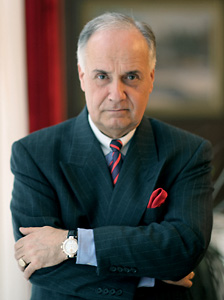 participated in the construction of modern Belgrade! participated in the construction of modern Belgrade!
After the shocks in Russia in the early XX century, Serbia offered sanctuary to thousands of Russian refugees. Among those who lost everything were also the flower of Russian national elite, and several dozens of architects and hundreds of civil engineers came to Serbia. The country was destroyed as a result of the destructive World War I. The Kingdom, which attempted to take its place in Europe, needed new architecture – academic, monumental, architecture of European level. The carriers of this mission – creating a new look of Yugoslavia, mainly Belgrade as the capital of the new united state – became Russian architects. And how good that was.
They performed their task successfully!
In twenty years (from 1921 to 1941) Russian experts designed and built several thousands of objects in the Kingdom, among them more than two thousand in Belgrade. The Russians built everything – from the government buildings and royal palace to small churches, private residential buildings, even cemeteries. Furthermore, they won their right to realize their designs exclusively through public competitions.
DEEDS THAT WILL OUTLIVE US
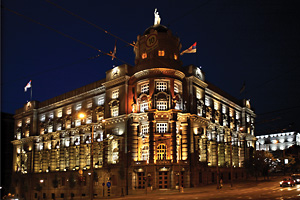 The most remarkable among Russian architects who worked in Serbia was Nikolai Krasnov (1864-1939), who came to Belgrade in 1922. Although his real name was Nikolai, as a sign of gratitude to his new motherland, he signed all his designs as ”Nikola”. The most remarkable among Russian architects who worked in Serbia was Nikolai Krasnov (1864-1939), who came to Belgrade in 1922. Although his real name was Nikolai, as a sign of gratitude to his new motherland, he signed all his designs as ”Nikola”.
N. Krasnov left a significant trace in the architecture of Belgrade. He designed the present government building, which was built from 1926 to 1928. He also designed the building of the Ministry of Foreign Affairs (built from 1926 to 1929). Krasnov also created the interior of the National Assembly building, as well as the Old Palace in Dedinje, decorated in the style of the Moscow Kremlin.
V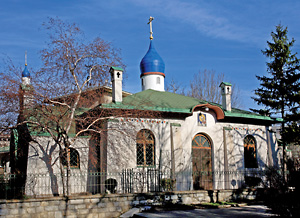 asily Fyodorovich Baumgarten (1879-?) designed the Army Headquarters, built from 1924 to 1928. The ”Russian Home” in Kraljice Natalije Street, the main institution of Russian refugees in Belgrade, was also built according to the design of this architect. The building of the Patriarchate of the Serbian Orthodox Church was designed by Victor Lukomsky (1884-1947). This is the most famous work of this Russian architect who came to Serbia in 1920. Valery Stashevsky (1882-1945) is one of the most interesting personalities among Russian architects in Belgrade. He designed about two thousand objects, among them also the Russian church in Tašmajdan. Vasily Androsov asily Fyodorovich Baumgarten (1879-?) designed the Army Headquarters, built from 1924 to 1928. The ”Russian Home” in Kraljice Natalije Street, the main institution of Russian refugees in Belgrade, was also built according to the design of this architect. The building of the Patriarchate of the Serbian Orthodox Church was designed by Victor Lukomsky (1884-1947). This is the most famous work of this Russian architect who came to Serbia in 1920. Valery Stashevsky (1882-1945) is one of the most interesting personalities among Russian architects in Belgrade. He designed about two thousand objects, among them also the Russian church in Tašmajdan. Vasily Androsov 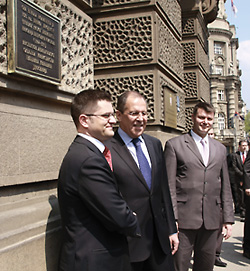 (1873-1934) had an important role in the final appearance of the Church of Aleksandar Nevsky. He also designed several public and residential buildings, among them the most famous being the façade of the Main Post Office building in Takovska Street. (1873-1934) had an important role in the final appearance of the Church of Aleksandar Nevsky. He also designed several public and residential buildings, among them the most famous being the façade of the Main Post Office building in Takovska Street.
Russian architects designed the exterior of the ”Moscow” hotel in the spirit of Russian modernism, and in 1972, during the reconstruction, the interior was beautified with numerous vitrages designed by Grigory Samoilov (1904-1989). Samoilov designed family villas, industrial objects, churches, and monumental edifices, such as the Pension Fund Palace which became one of the symbols of Terazije, central Belgrade street. Among sacral objects, the most famous work of Samoilov is the Church of Holy Archangel Gabriel, erected in 1939.
TRACES OF NOBLE DECORATIVENESS
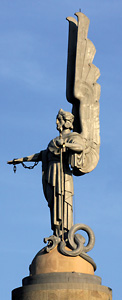 Unfortunately, fate was not favorable to many Russian refugees in Serbia, including the famous architects among them. First the aggression of fascist Germany on Yugoslavia, then the fear of the arrival of the Red Army, finally the inglorious Informbiro resolution in 1948, forced them to find new lands for themselves – to leave everything again and emigrate. Only Grigory Samoilov can be considered a lucky exemption, whose talent after 1945 was expressed in the design of edifices such as the Academy of Sciences and Yugoslav Bank for Foreign Trade. Unfortunately, fate was not favorable to many Russian refugees in Serbia, including the famous architects among them. First the aggression of fascist Germany on Yugoslavia, then the fear of the arrival of the Red Army, finally the inglorious Informbiro resolution in 1948, forced them to find new lands for themselves – to leave everything again and emigrate. Only Grigory Samoilov can be considered a lucky exemption, whose talent after 1945 was expressed in the design of edifices such as the Academy of Sciences and Yugoslav Bank for Foreign Trade.
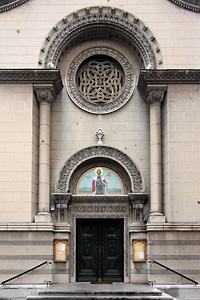 Today, many decades later, it is clearly seen what the Russian architects did for Serbia. They properly served their new Motherland. Their contribution to the development of Serbian architecture and introducing new tendencies are immeasurable. Many edifices built according to their designs were proclaimed cultural monuments. Russian architects largely determined the appearance of the Belgrade city center formed until World War II. In almost every Belgrade street we can see a home with noble decorativeness testifying about the Russian origins of the architect. Today, many decades later, it is clearly seen what the Russian architects did for Serbia. They properly served their new Motherland. Their contribution to the development of Serbian architecture and introducing new tendencies are immeasurable. Many edifices built according to their designs were proclaimed cultural monuments. Russian architects largely determined the appearance of the Belgrade city center formed until World War II. In almost every Belgrade street we can see a home with noble decorativeness testifying about the Russian origins of the architect.
However, time passes by. The Russian authors who created the face of Belgrade and other Serbian cities are not with us any more, and neither are those who knew them personally. For the past ten years, only two modest exhibitions in Belgrade were dedicated to the heritage of Russian architects in Serbia, organized by a small group of enthusiasts. It is time to think about what must be done for the future to preserve the memory of those who built their architectural deeds into the recognition of Belgrade, Niš, Bela Crkva, Smederevo and many other cities in Serbia.
***
About the Author
Alexander Vasilevich Konuzin (1947) graduated from the Moscow State Institute for International Relations (MIP) in 1971, and has been a diplomat ever since. He worked in his country’s embassies in Cameron (1971-1973), Gabon (1974-1978), Algeria (1981-1986), France (1991-1996), and the Permanent Mission of Russia to the UN in New York (2001-2005). From 2005 to 2008 he was director of the Department for International Organizations of the Russian Ministry of Foreign Affairs.
From April 18, 2008, following the decision of the president of Russia Vladimir Putin, he is the Ambassador Extraordinary and Plenipotentiary of the Russian Federation in Serbia.
Married, one daughter. Speaks English and French.
***
Marks
I am grateful from the bottom of my heart to the city administrations of Belgrade and Niš, which, upon my appeal, placed memorial plates on the most important edifices designed by Russians. The first of them was presented on the Serbian Ministry of Foreign Affairs building by the ministers of foreign affairs of the two countries – Vuk Jeremić and Sergei Lavrov.
|
